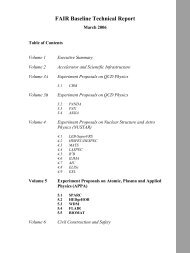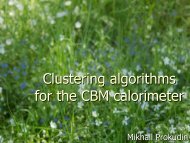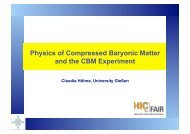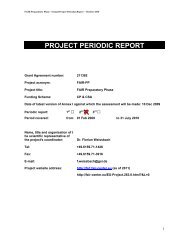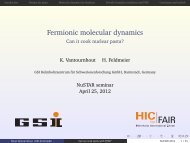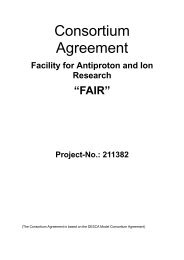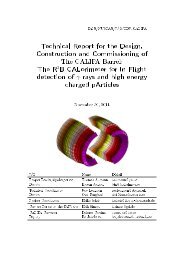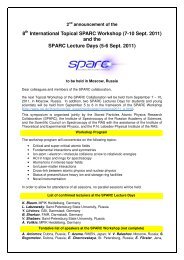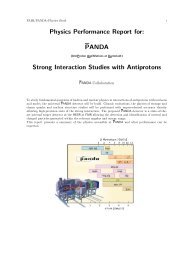NeuLAND - FAIR
NeuLAND - FAIR
NeuLAND - FAIR
You also want an ePaper? Increase the reach of your titles
YUMPU automatically turns print PDFs into web optimized ePapers that Google loves.
heavy neutron-rich nuclei [Bro-00], [Hor-01]. A first attempt to extract the parameters<br />
describing the neutron-proton asymmetry part of the equation of state for nuclear matter<br />
from the measured low-lying dipole strength has been made by Kliemkiewicz et al.<br />
[Kli-07] and by Carbone et al. [Car-10]. Experimental data concerning the collective response<br />
of exotic nuclei including the giant resonances and the pygmy dipole strength are<br />
still rather scarce. The existing dipole strength measurements suffer from an insufficient<br />
response of the detector system.<br />
From the experimental point of view, there are several challenges to deal with. The<br />
heavy-ion induced electromagnetic excitation process requires high beam energies which<br />
in turn put high demands on the detection systems. The combination of a largeacceptance<br />
superconducting dipole with large field integral, a highly granular calorimeterlike<br />
photon detector together with a high-efficiency and high-resolution detection of<br />
neutrons make the R 3 B setup an ideal facility to study the collective response of exotic<br />
nuclei.<br />
The neutron detector has to be optimized for high detection efficiency and acceptance in<br />
the beam-energy region from 200 to 1000 AMeV. A variation of beam energy is necessary<br />
to disentangle dipole and quadrupole contributions to the excitation cross section. The<br />
lower energy of 200 AMeV will be used to study giant monopole resonances in neutronrich<br />
nuclei which are related to the incompressibility of asymmetric nuclear matter. We<br />
will use alpha scattering in inverse kinematics in an active He gas target which will be<br />
developed for these measurements. For heavy nuclei, like Pb, the beam energies around<br />
1 AGeV are necessary to allow for fully stripped ion beams. It is mandatory to apply<br />
a magnetic analysis for an identification of the fragments using a tracking system. So<br />
far, this has not been possible due to the limitations of the present detection devices.<br />
The improved resolution of <strong>NeuLAND</strong> will make a high-resolution detection of neutrons<br />
possible even at a laboratory energy of 1 AGeV.<br />
The kinetic energy of neutrons evaporated from collective states in the continuum follows<br />
usually a Maxwellian distribution with a maximum at approximately 1 to 2 MeV.<br />
An angular acceptance which allows detection of up to about 5 MeV kinetic energy is<br />
required to cover the full distribution. This requirement is met by the ±80 mrad acceptance<br />
defined by the gap of the dipole magnet and will be covered by the neutron<br />
detector. The envisaged position and time resolution of 1.5 cm and 150 ps for <strong>NeuLAND</strong><br />
will result in an excitation energy resolution of about 100 keV at an excitation energy<br />
of 1 MeV above the threshold (or 1 MeV kinetic energy of the neutron) for a 600 AMeV<br />
beam at a distance fulfilling the full-acceptance criterium. At 1 AGeV, the detector can<br />
be placed further away while providing the same acceptance and about the same energy<br />
resolution.<br />
The high intensities of radioactive beams provided by the Super-FRS at <strong>FAIR</strong> will<br />
push the frontier towards more neutron-rich systems. In such nuclei, the effects of<br />
asymmetry are magnified and the electromagnetic response of the nucleus reflects these<br />
isospin-related changes. The Pygmy resonance is one example, but also the dipole and<br />
quadrupole response as a whole change. The neutron-rich medium-mass nuclei which can<br />
20





